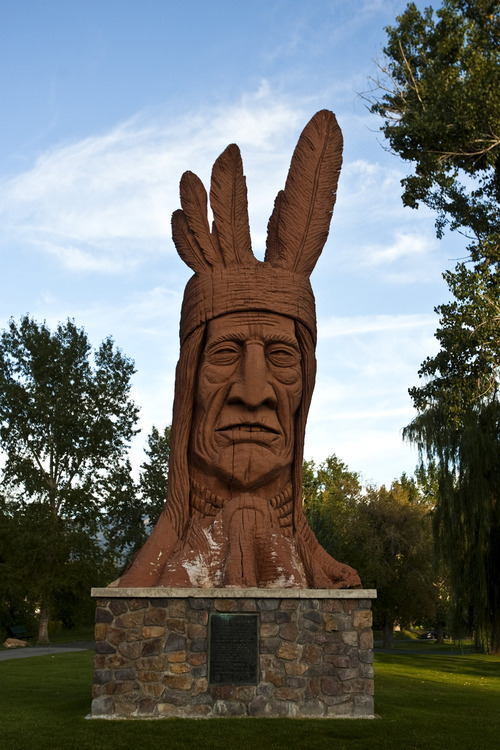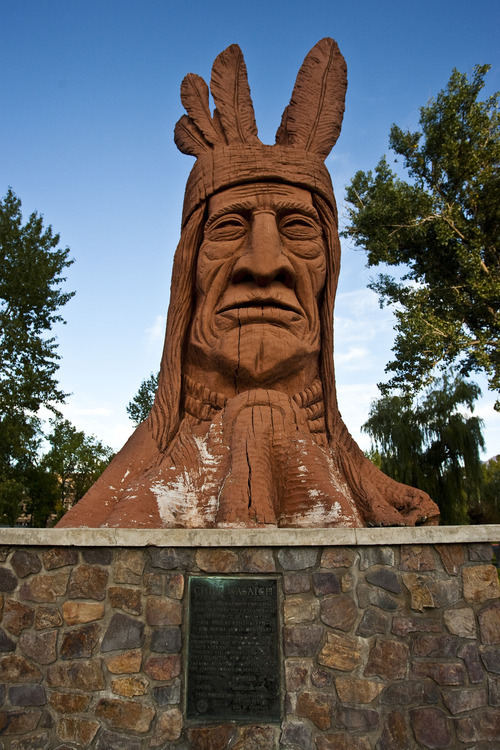This is an archived article that was published on sltrib.com in 2011, and information in the article may be outdated. It is provided only for personal research purposes and may not be reprinted.
Every Friday and Saturday these days, nature's bounty appears at Murray Park. Hundreds of people stroll past boxes of peaches, apples, pumpkins, squash, beans, tomatoes, melons and corn. Almost everyone who comes to this farmers' market passes by a 23-foot-tall woodcarving of an American Indian head.
He's "Chief Wasatch," and he's been standing at the entrance to Murray Park for 26 years. Where did he come from?
William B. Smart tells this story: During the 1980s Smart was in Valdez, Alaska, where he saw a huge carving of an American Indian. He learned that the artist had been creating a statue like this for every state.
The man's name was Peter Wolf Toth. Born in 1947 in Hungary, Toth grew up as one of 11 children in an oppressed country and was only 9 years old during the Hungarian Revolt. Before the Soviets and their tanks rolled in to clamp down on the revolutionaries, the family fled the country, walking through icy swamps into then-Yugoslavia and living for a couple of years in refugee camps. Eventually they settled in Ohio.
Native American history inspired Toth. He felt a connection with these people who had been oppressed just as his people had been. As a young artist in his 20s, he got the idea to honor American Indians by creating a giant statue in each state. He would call these creations "Whispering Giants."
Smart, who was chairing the Provo-Jordan River Parkway board at the time, thought Toth could perhaps put his Utah statue alongside the Jordan River. He called Toth, who said he'd be glad to come. If Utah could get a huge tree stump and a foundation to put it on, he'd do the rest. Smart asked him what it would cost. Nothing, said Toth. Just food and a place to camp.
Lynn Pett, Parks and Recreation Director for Murray City (and later its mayor), was also on the Parkway board. Pett says that the Parkway administrators turned down the statue and asked if Murray would like it. "I said I'd love it," Pett says. "But I don't know if we can get a tree big enough."
Two giant cottonwood trees were growing along the Jordan River near 4800 South. Pett and Toth went to take a look and decided they would work. Toth offered to carve an eagle out of one and "Chief Wasatch" out of the other.
So the sculptor began working with his chainsaw, hammer and chisel. Pictures from the time show him up on scaffolding working on the stump sporting a beard, big round glasses, a fringed buckskin vest, and a headband.
"He had an old van where he slept, and he had his tools, and he just camped there and ate his meals," says Smart. "He just stayed there and worked on it and he didn't want a cent of pay for it."
He spent three months working. When Chief Wasatch was finished and fixed to its pedestal on the west end of the park, Murray held a dedication ceremony. The plaque reads that the statue was created "to raise the nation's conscience to the plight of the first Americans so they won't be forgotten — but will be remembered in our minds and in our hearts. This statue is sculpted out of a giant cottonwood tree in honor of Utah Native Americans — Southern and Northern Ute, southern Shoshone, Goshutes, Paiute, and Navajo. Dedicated November 23, 1985."
The eagle went to the east end of the park, but after several years it rotted out and had to be removed, Pett says.
Unfortunately, Chief Wasatch is also made of cottonwood, and subject to rotting. The city is doing its best to keep the monument standing. It is a losing cause — nothing can prevent the wood from returning to the earth eventually. But for as long as it stands, if you're driving down State Street, you might want to stop and take time to appreciate a remarkable creation — and to acknowledge both the indigenous peoples it honors and the generous artist who gifted it to the people of Utah.
Kristen Iversen lives in Salt Lake City.
Sources: Interviews with William Smart and Lynn Pett.





